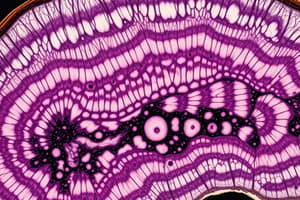Podcast
Questions and Answers
Trimming is the process of removing excess ______ after embedding.
Trimming is the process of removing excess ______ after embedding.
wax
Four-sided prism or Truncated Pyramid shape is used to ensure at least 2mm of ______ should surround the tissue block.
Four-sided prism or Truncated Pyramid shape is used to ensure at least 2mm of ______ should surround the tissue block.
wax
Recommended Thickness of Tissue Sections for routine histologic procedure is 4 - 5μ, for Frozen Sections is 10 - 15μ, and for Electron Microscopy is ______.
Recommended Thickness of Tissue Sections for routine histologic procedure is 4 - 5μ, for Frozen Sections is 10 - 15μ, and for Electron Microscopy is ______.
0.5μ
Rocking Microtome, also known as Cambridge Rocking Microtome, is used for large blocks of paraffin embedded tissues and was invented by Paldwell-Trefall on ______.
Rocking Microtome, also known as Cambridge Rocking Microtome, is used for large blocks of paraffin embedded tissues and was invented by Paldwell-Trefall on ______.
The sliding microtome is used for celloidin embedded tissue sections. Knife = ______; Tissue block = moving
The sliding microtome is used for celloidin embedded tissue sections. Knife = ______; Tissue block = moving
The freezing microtome is also known as Cryostats/Cold ______. Temperature should be maintained at - 5 to -30°C
The freezing microtome is also known as Cryostats/Cold ______. Temperature should be maintained at - 5 to -30°C
The VIBROTOME is used for unfixed, unfrozen specimen section for ______ demonstration
The VIBROTOME is used for unfixed, unfrozen specimen section for ______ demonstration
ULTRATHIN MICROTOME is for cutting sections for ______ Microscopy
ULTRATHIN MICROTOME is for cutting sections for ______ Microscopy
The sliding microtome is used for celloidin embedded tissue sections. Knife = ______; Tissue block = moving
The sliding microtome is used for celloidin embedded tissue sections. Knife = ______; Tissue block = moving
The sliding microtome is used for celloidin embedded tissue sections. Knife = moving; Tissue block = ______
The sliding microtome is used for celloidin embedded tissue sections. Knife = moving; Tissue block = ______
ULTRATHIN MICROTOME is for cutting sections for ______ Microscopy
ULTRATHIN MICROTOME is for cutting sections for ______ Microscopy
The freezing microtome is also known as Cryostats/Cold ______. Temperature should be maintained at - 5 to -30°C
The freezing microtome is also known as Cryostats/Cold ______. Temperature should be maintained at - 5 to -30°C
The sliding microtome is used for celloidin embedded tissue sections. Knife = moving; Tissue block = ______
The sliding microtome is used for celloidin embedded tissue sections. Knife = moving; Tissue block = ______
Recommended Thickness of Tissue Sections for routine histologic procedure is 4 - 5μ, for Frozen Sections is 10 - 15μ, and for Electron Microscopy is ______.
Recommended Thickness of Tissue Sections for routine histologic procedure is 4 - 5μ, for Frozen Sections is 10 - 15μ, and for Electron Microscopy is ______.
The sliding microtome is used for celloidin embedded tissue sections. Knife = ______; Tissue block = moving
The sliding microtome is used for celloidin embedded tissue sections. Knife = ______; Tissue block = moving
The freezing microtome is also known as Cryostats/Cold ______. Temperature should be maintained at - 5 to -30°C
The freezing microtome is also known as Cryostats/Cold ______. Temperature should be maintained at - 5 to -30°C
The VIBROTOME is used for unfixed, unfrozen specimen section for ______ demonstration
The VIBROTOME is used for unfixed, unfrozen specimen section for ______ demonstration
ULTRATHIN MICROTOME is for cutting sections for ______ Microscopy
ULTRATHIN MICROTOME is for cutting sections for ______ Microscopy
Trimming is the process of removing excess ______ after embedding.
Trimming is the process of removing excess ______ after embedding.
Rocking Microtome, also known as Cambridge Rocking Microtome, is used for large blocks of paraffin embedded tissues and was invented by Paldwell-Trefall on ______.
Rocking Microtome, also known as Cambridge Rocking Microtome, is used for large blocks of paraffin embedded tissues and was invented by Paldwell-Trefall on ______.
Flashcards are hidden until you start studying
Study Notes
Trimming and Microtome
- Trimming is the process of removing excess wax after embedding.
- A four-sided prism or Truncated Pyramid shape is used to ensure at least 2mm of wax surrounds the tissue block.
Thickness of Tissue Sections
- Recommended thickness for routine histologic procedure is 4-5μ.
- Recommended thickness for Frozen Sections is 10-15μ.
- Recommended thickness for Electron Microscopy is 60-90μ.
Microtome Types
- Rocking Microtome (also known as Cambridge Rocking Microtome) is used for large blocks of paraffin embedded tissues and was invented by Paldwell-Trefall in 1885.
- Sliding Microtome is used for celloidin embedded tissue sections, where the knife is stationary and the tissue block is moving.
- Freezing Microtome is also known as Cryostats/Cold Plate, and the temperature should be maintained at - 5 to -30°C.
- Vibrotome is used for unfixed, unfrozen specimen section for demonstration of delicate structures.
- Ultrathin Microtome is used for cutting sections for Electron Microscopy.
Studying That Suits You
Use AI to generate personalized quizzes and flashcards to suit your learning preferences.




